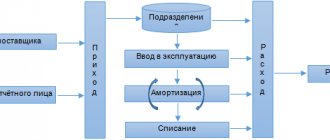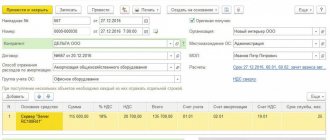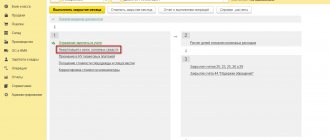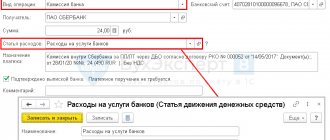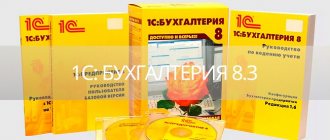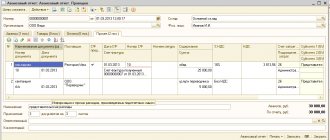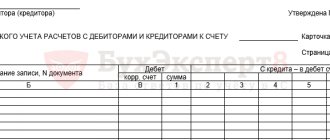Receipt and acceptance for accounting of OS in 1C 8.3
The purchase of fixed assets can be registered in the 1C Accounting 3.0 program with the document “Receipts (acts, invoices)”, selecting the appropriate type (“equipment” or “fixed assets”).
Our team provides consulting, configuration and implementation services for 1C. You can contact us by phone +7 499 350 29 00 . Services and prices can be seen at the link. We will be happy to help you!
For convenience, this document is also located in the “Fixed assets and intangible assets” menu in the form of two items with already established types: “Receipt of fixed assets” and “Receipt of equipment”.
A document with the type “Fixed Assets” is needed to account for those assets that do not require installation and additional costs.
- In the latest editions of 1C Accounting 8.3 (starting from 3.0.45), when using this type of operation, you do not need to additionally create the “Acceptance for accounting of fixed assets” document. All postings are made as receipts with the type of operation “Fixed Assets”, which greatly simplifies the life of accountants.
- The type of operation “Equipment” implies a purchase on accounts: 08.04.1 and 07. Equipment received on account 07 requires further installation. The equipment that arrived to the account on 08.04 does not require installation, and in the future should be accepted for accounting. VAT is reflected on the account on 19.01.
In our example, we will consider the receipt of fixed assets, since this functionality is new. To do this, in the “Fixed assets and intangible assets” menu, select the “Receipt of fixed assets” item. In the list form that opens, create a new document.
As you can see, it combines the details of receipt and acceptance for accounting.
Fill out the counterparty and the agreement in the header of the document. The method for reflecting depreciation expenses will be filled in automatically, but you can adjust it if desired. You can also indicate the location of the OS and the financially responsible person, but these fields are not mandatory. In the event that this object will be rented out, it is necessary to set the appropriate flag.
Next, fill out the tabular part of the document, making sure to indicate the service life for each item in months. If any of the positions has not been created previously, it must be created.
It is very convenient to create a new fixed asset directly from the tabular part of this document. For the created object, the OS accounting group will be set in accordance with the value specified in the header. The depreciation group is filled in when recording a document with a value corresponding to the specified service life.
Free receipt of fixed assets in 1C: Accounting 8 edition 3.0
One of the options for receiving an object of fixed assets to an organization is to receive it free of charge under a gift agreement.
Under a gift agreement, one party (the donor) gratuitously transfers or undertakes to transfer to the other party (the donee) a thing in ownership or a property right (claim) to himself or a third party, or releases or undertakes to release it from a property obligation to himself or to a third party (p .1 Article 572 of the Civil Code of the Russian Federation (Civil Code of the Russian Federation)).
In this article, we will look at a specific example of how to reflect in the 1C: Accounting 8 edition 3.0 program the receipt by an organization from an individual under a donation agreement of an object of fixed assets and its acceptance for accounting and tax accounting.
Let's look at an example. The organization "Rassvet" applies the general taxation regime - the accrual method and PBU 18/02 "Accounting for calculations of corporate income tax." The organization is a VAT payer.
In May 2021, the Rassvet organization received from an individual Sidorov S.S. under a gift agreement, a new (not used) fixed asset item. The market value of the property is 120,000 rubles. Sidorov made the payment to the independent appraiser. To bring the facility to a usable state, the services of a third party were required. The cost of services is 6,000 rubles, including VAT 20% (1,000 rubles). In the same month, the fixed asset item was accepted for accounting and put into operation in the Directorate division. The object belongs to the second depreciation group. The useful life is set, in accordance with OKOF, equal to 25 months, depreciation is calculated using the straight-line method.
In accounting, an asset received by an organization under a gift agreement fully satisfies the conditions established in clause 4 of PBU 6/01 and is accepted for accounting at its original cost. In accordance with clause 10 of PBU 6/01, the initial cost of fixed assets received by an organization under a gift agreement (free of charge) is recognized as their current market value on the date of acceptance for accounting as investments in non-current assets.
Acceptance for accounting of an object of fixed assets received by an organization free of charge, in accordance with clause 29 of the Guidelines for the accounting of fixed assets, is reflected in the debit of account 08 “Investments in non-current assets” in correspondence with the credit of account 98 “Deferred income” with the subsequent reflected in the debit of account 01 “Fixed assets” in correspondence with the credit of account 08.
For profit tax purposes, the received object satisfies the requirements of paragraph 1 of Art. 256 of the Tax Code of the Russian Federation (TC RF) and is recognized as depreciable property. In accordance with paragraph 1 of Art. 257 of the Tax Code of the Russian Federation, if the fixed asset was received free of charge, then its initial cost is determined as the amount at which such property is valued in accordance with clause 8 of Art. 250 of the Tax Code of the Russian Federation (market value).
Typically, the receipt of an item of fixed assets is reflected in the program using the document Receipt with the type of operation Equipment or the type of operation Fixed Assets, but we have a special “free” receipt, in which the differences between accounting and tax accounting are recognized. The Receipt document cannot fully process such an operation without manually adjusting the postings. Therefore, we will use the document Operation (accounting statement).
In the tabular part of the document, we will add entries that comply with the methodological instructions. By debit, select account 08.04.1 “Purchase of components of fixed assets” and fill in its analytics. As the first subconto, we will indicate the received fixed asset object - an element of the Nomenclature directory with the item type Equipment (fixed asset objects).
As the second sub-account (the accounting policy of the organization establishes a method for assessing inventories using FIFO), we will create and select the document Batch in which we will indicate the donor counterparty and the gift agreement (Fig. 1).
Picture 1.
As the third subaccount (we have warehouse accounting installed in the program), we will indicate the storage location, in our case - the Main warehouse. Let’s not forget to indicate the number of fixed assets - 1. For the loan, we will select account 98.02 “Gratuitous receipts”. In the initial state in the program, this subaccount in the chart of accounts does not have any analytics. This is not very convenient, so I decided to add analytics to the account (although you can do without analytics) (Fig. 2).
Figure 2.
Let's fill out the analytics of the above account and get into the amounts. As we have already said, in accounting and for profit tax purposes, the value of property received free of charge is its current market value (details Amount and NU Amount Dt). But we have some problems with the NU Amount Kt details, since, in accordance with clause 8 of Art. 250 of the Tax Code of the Russian Federation, the market value of property received free of charge is recognized as non-operating income, and not deferred income, as in accounting. Therefore, we will reset the above amount and reflect the corresponding temporary difference (BP Amount Kt).
We will add the second wiring by copying. Let's reset the Quantity of Dt and replace the loan account (98.02) with account 91.01 “Other income”. As an analytics, we will select (create) an item of other income and expenses with the type Free receipt of property, work, services, property rights. In this posting, we will indicate only the amount of the loan in tax accounting (NU Amount Kt) and reflect the corresponding temporary difference with a minus sign (BP Amount Kt).
An example of filling out the Operation document is shown in Fig. 3.
Figure 3.
In accounting and tax accounting, an asset is taken into account at its original cost, and the initial cost is the amount of actual costs. Therefore, the costs associated with bringing the fixed asset to a state suitable for use are included in the initial cost of the fixed asset.
To perform this operation in the program, you can use the document Additional Receipt. expenses.
The header of the document indicates the contractor who performed the work and the agreement with him, the cost of the work performed, the method of distribution, and the VAT rate.
The tabular part on the Products tab is filled in manually. The fixed asset received under the gift agreement is selected, the quantity and amount are indicated, and the batch document is selected. Accounting accounts are filled in automatically. The only thing is that the VAT invoice presented, in my opinion, you need to select 19.01 “VAT on the acquisition of fixed assets.”
In the “footer” of the document, the invoice received from the counterparty is registered (the document Invoice received is created).
When carried out, the document in accounting and tax accounting will reflect on the debit of account 08.04.1 in correspondence with the credit of account 60.01 “Settlements with suppliers and contractors” the costs associated with bringing the fixed asset to a state suitable for use, and will allocate on the debit of account 19.01 the amount presented by the counterparty VAT. The document will also make an entry in the VAT accumulation register presented.
Example of filling out the document Receipt of additional. expenses and its result are shown in Fig. 4.
Figure 4.
The organization has the right to deduct the amount of VAT presented by the work supplier. In the program, VAT can be deducted using the regulatory document Formation of purchase ledger entries, or directly in the Invoice document received, with the Reflect VAT deduction in the purchase ledger by the date of receipt checkbox enabled. In our example, the second method is used. Therefore, when posted, the document Invoice received will take for deduction the amount of VAT presented by the supplier, creating in accounting an entry for the debit of account 68.02 in correspondence with the credit of account 19.01. Writes off the VAT accumulation register presented and makes an entry in the Purchases VAT accumulation register (purchase book).
The Invoice document received and the result of its execution are shown in Fig. 5.
Figure 5.
You have to pay for the work. To perform this operation in the program, we will use the document Receipt to current account with the transaction type Payment to supplier. The document Receipt to the current account and its posting are shown in Fig. 6.
Figure 6.
To reflect the fact of acceptance for accounting and commissioning of a fixed asset object, the program uses the document Acceptance for accounting of fixed assets with the type of operation Equipment.
The header of the document indicates the financially responsible person, the location of the fixed asset and the event Acceptance for accounting with commissioning.
On the Non-current asset tab, the method of receipt of the fixed asset item is indicated and the corresponding element is selected from the Nomenclature directory, accounting account 08.04.1 is set automatically.
In the tabular section, on the Fixed Assets tab, a fixed asset (an element of the Fixed Assets directory) is created and an inventory number is assigned to it.
On the Accounting tab, the accounting account is indicated - 01.01 “Fixed assets in the organization”, the accounting procedure is Depreciation, the depreciation account is 02.01 “Depreciation of fixed assets accounted for on account 01”, the method of calculating depreciation, the method of reflecting depreciation expenses and the useful life use.
On the Tax Accounting tab, the procedure for including costs in expenses and the useful life are indicated.
When posting a document in accounting and tax accounting, it will write off the generated initial cost of the fixed asset from the credit of account 08.04.1 to the debit of account 01.01 and generate entries in many special registers of information for accounting for fixed assets.
An example of filling out the document Acceptance for accounting of fixed assets and the result of its implementation are shown in Fig. 7.
Figure 7.
When property is received free of charge, income from future periods is recognized in accounting, and for profit tax purposes, income is recognized in the current period. Consequently, in accordance with clause 11 of PBU 18/02, deductible temporary differences arise (we reflected them in the Operation document). Deductible temporary differences (DTD) lead to the recognition of a deferred tax asset (DTA), the amount of which can be calculated using the following formula:
SHE = VVR * STnp = 120,000 rubles * 20% = 24,000 rubles
The functions of PBU 18/02 in the program are performed by the regulatory operation Calculation of income tax. The movement of temporary differences and the recognition of deferred tax assets and liabilities can be conveniently tracked using a special calculation certificate, Deferred tax assets and liabilities, which can be generated directly at the end of the month.
The calculation certificate and posting of the scheduled operation for May are presented in Fig. 8.
Figure 8.
In accordance with clause 4 of PBU 6/01, the cost of fixed assets is repaid through depreciation. Depreciation on a fixed asset item begins on the first day of the month following the month in which this item was accepted for accounting (clause 21 of PBU 6/01).
In accordance with paragraph 4 of Art. 259 of the Tax Code of the Russian Federation, the calculation of depreciation for depreciable property objects begins on the 1st day of the month following the month in which this object was put into operation.
Consequently, in June, depreciation will begin to be calculated in accounting and tax accounting. With the linear method of calculating depreciation, the monthly amount of depreciation charges in accounting and for profit tax purposes is calculated using the following formula:
Am = STp / SPI = 125,000 rubles / 25 months = 5,000 rubles
Posting of the routine operation Depreciation and depreciation of fixed assets for June 2021 is presented in Fig. 9.
Figure 9.
In accordance with clause 29 of the Methodological Guidelines for Accounting for Fixed Assets, for the amount of the initial cost of fixed assets received by the organization under a gift agreement (free of charge), the financial results of the organization are formed during the useful life as other income. Therefore, simultaneously with the calculation of depreciation, the corresponding amount of deferred income must be written off from the debit of account 98 to the credit of account 91. Therefore, before closing the month, in order to perform the above operation, it is necessary to create an Operation document.
The monthly write-off amount for deferred income (DBP) can be calculated using the following formula:
Write-off amount = DBP / SPI amount = 120,000 rubles / 25 months = 4,800 rubles.
In the document it is necessary to create only one transaction: Dt 98.02 – Kt 91.01. As an analytics for account 91.01, you must select the item of other income and expenses with the type Free receipt of property, work, services, property rights (the same item that we used when receiving fixed assets). Only the accounting amount is filled in in the posting and the corresponding amounts of temporary differences are reflected. Such a document must be generated every month during the useful life of the fixed asset.
Filling out the document Operation is shown in Fig. 10.
Figure 10.
Thus, in June, when writing off future income, other income is recognized in accounting, but for income tax purposes there is no income (all of it was already recognized in the previous period), therefore, in accordance with clause 12 of PBU 18/ 02, taxable temporary differences arise (we have just reflected them). Taxable temporary differences (TDT) result in the recognition of a deferred tax liability (DTL) or the settlement of a deferred tax asset (DTA), provided that it has been accrued. The OTA repayment amount is calculated using the formula:
Repayment ONA = NVR * STnp = 4,800 rubles * 20% = 960 rubles
The reference calculation and posting of the regulatory transaction Calculation of income tax for June are presented in Fig. eleven.
Figure 11.
Other income received by the organization from writing off deferred income on gratuitously received property and the accrued deferred tax asset are reflected in the Statement of Financial Results.
A fragment of the Financial Results Report of the Rassvet organization for the first half of the year is presented in Fig. 12.
Figure 12.
For profit tax purposes, non-operating income recognized upon gratuitous receipt of property is reflected in the income tax return.
A fragment of Appendix 1 to sheet 02 of the income tax return of the organization “Rassvet” for the first half of the year is presented in Fig. 13.
Figure 13.
VAT upon receipt of fixed assets
In this example, VAT was posted, since the document parameters indicate that it is not included in the price. To change this setting, follow the corresponding hyperlink in the document header and check the “Include VAT in price” flag. Then, when posting the document, there will be no movement on the account 19.01.
VAT will be reflected in the purchase book only after an invoice has been registered for this document.
If the receipt was reflected in a document with the transaction type “Receipt of equipment”, then it is additionally necessary to accept the fixed asset for accounting. This document is located in the menu “Fixed assets and intangible assets”, item “Acceptance for accounting of fixed assets”. We will not consider filling out this document, since we filled out all the necessary data, both for receipt and for acceptance for accounting, using the “Receipt of fixed assets” transaction type.
Gifts for employees
Cozy Home organization gives its employees gifts for their anniversary.
On February 1, we purchased sets of sweets at a price of 1,200 rubles. per piece, including VAT 20%.
On February 10, gifts were presented to employees.
Purchasing gifts
Reflect the purchase of candy using the standard document Receipt (act, invoice) in the Purchases – Receipt (acts, invoice, invoice) menu.
In total, 15 sets of sweets were purchased for the amount of 18,000 rubles, including VAT of 3,000 rubles. We take VAT for deduction, so in the VAT accounting method , select the option Accepted for deduction .
Acceptance of VAT for deduction
To reflect the VAT deduction, create a document Creating purchase ledger entries (Operations – Regular VAT transactions), click the Create button – Generating purchase ledger entries.
Free transfer of goods
To account for a gratuitous transfer, go to the Sales – Gratuitous Transfer section and create a document of the same name.
Fill in the information:
- Number ... from - the number will be assigned automatically, transaction date - the date of gift transfer;
- Organization - indicate your organization;
- Warehouse —warehouse for storing gifts;
- Recipient - although it is highlighted in red, it is not always filled in. If there is a specific recipient, indicate it. In this example, a general document is created for all employees, so leave the field blank.
On the Goods , select the goods to be transferred, their quantity and market value (in our example, the cost of purchasing candy without VAT). account will be determined automatically.
On the Cost Account , check:
- Cost account - 91.02 “Other expenses”;
- VAT account — 91.02.
For the subconto Other income and expenses, a predefined item is selected:
- Expenses for the transfer of goods (work, services) free of charge : Type of article - Expenses for the transfer of goods (work, services) free of charge and for one’s own needs .
Make sure that in the selected option the Accepted for tax accounting .
Save the document and create an invoice using the Issue invoices . Since the transfer is gratuitous, the transaction type code will be 10 “Gratuitous transfer of goods, works, services.”
Postings according to the document
The document generates transactions:
- Dt 91.02 Kt 41.01 - writing off the cost of goods as other expenses not taken into account in the NU;
- Dt 91.02 Kt 68.02 - calculation of VAT on the transfer with write-off to other expenses not taken into account in the NU.
Invoice registration
Let's register an invoice for this document. To do this, enter its number, date at the bottom and click on the “Register” button.
After this, a link to the created document will be displayed.
Also watch a video on how to formalize the commissioning of an OS in two steps - first receipt, and then acceptance for accounting:
Receipt of additional expenses for the operating system
The initial cost of equipment and other fixed assets is formed at the acquisition stage not only from the purchase price, but also from installation costs and other expenses associated with the acquisition.
Therefore, it is worth considering two documents:
- Receipt of additional expenses
- Transfer of equipment for installation
You can create them in the section “Fixed assets and intangible assets” - Receipt of fixed assets. As usual, documents are created by clicking the "Create" button. In the header of the document, fill in the standard details - Organization and Counterparty.
In the tabular section, in the “Main” tab, the amount of additional costs is indicated:
On the “Products” tab, the fixed asset item is indicated, the cost of which includes these expenses:
